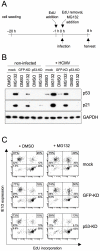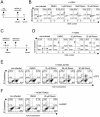Cyclin-dependent kinase activity controls the onset of the HCMV lytic cycle
- PMID: 20844576
- PMCID: PMC2936547
- DOI: 10.1371/journal.ppat.1001096
Cyclin-dependent kinase activity controls the onset of the HCMV lytic cycle
Abstract
The onset of human cytomegalovirus (HCMV) lytic infection is strictly synchronized with the host cell cycle. Infected G0/G1 cells support viral immediate early (IE) gene expression and proceed to the G1/S boundary where they finally arrest. In contrast, S/G2 cells can be infected but effectively block IE gene expression and this inhibition is not relieved until host cells have divided and reentered G1. During latent infection IE gene expression is also inhibited, and for reactivation to occur this block to IE gene expression must be overcome. It is only poorly understood which viral and/or cellular activities maintain the block to cell cycle or latency-associated viral IE gene repression and whether the two mechanisms may be linked. Here, we show that the block to IE gene expression during S and G2 phase can be overcome by both genotoxic stress and chemical inhibitors of cellular DNA replication, pointing to the involvement of checkpoint-dependent signaling pathways in controlling IE gene repression. Checkpoint-dependent rescue of IE expression strictly requires p53 and in the absence of checkpoint activation is mimicked by proteasomal inhibition in a p53 dependent manner. Requirement for the cyclin dependent kinase (CDK) inhibitor p21 downstream of p53 suggests a pivotal role for CDKs in controlling IE gene repression in S/G2 and treatment of S/G2 cells with the CDK inhibitor roscovitine alleviates IE repression independently of p53. Importantly, CDK inhibiton also overcomes the block to IE expression during quiescent infection of NTera2 (NT2) cells. Thus, a timely block to CDK activity not only secures phase specificity of the cell cycle dependent HCMV IE gene expression program, but in addition plays a hitherto unrecognized role in preventing the establishment of a latent-like state.
Conflict of interest statement
The authors have declared that no competing interests exist.
Figures












Similar articles
-
Human cytomegalovirus tegument protein pp150 acts as a cyclin A2-CDK-dependent sensor of the host cell cycle and differentiation state.Proc Natl Acad Sci U S A. 2013 Oct 22;110(43):17510-5. doi: 10.1073/pnas.1312235110. Epub 2013 Oct 7. Proc Natl Acad Sci U S A. 2013. PMID: 24101496 Free PMC article.
-
Inhibition of human cytomegalovirus immediate-early gene expression by cyclin A2-dependent kinase activity.J Virol. 2012 Sep;86(17):9369-83. doi: 10.1128/JVI.07181-11. Epub 2012 Jun 20. J Virol. 2012. PMID: 22718829 Free PMC article.
-
General blockade of human cytomegalovirus immediate-early mRNA expression in the S/G2 phase by a nuclear, Daxx- and PML-independent mechanism.J Gen Virol. 2011 Dec;92(Pt 12):2757-2769. doi: 10.1099/vir.0.034173-0. Epub 2011 Aug 10. J Gen Virol. 2011. PMID: 21832009
-
Human cytomegalovirus riding the cell cycle.Med Microbiol Immunol. 2015 Jun;204(3):409-19. doi: 10.1007/s00430-015-0396-z. Epub 2015 Mar 17. Med Microbiol Immunol. 2015. PMID: 25776080 Review.
-
Chromatin structure regulates human cytomegalovirus gene expression during latency, reactivation and lytic infection.Biochim Biophys Acta. 2010 Mar-Apr;1799(3-4):286-95. doi: 10.1016/j.bbagrm.2009.08.001. Epub 2009 Aug 12. Biochim Biophys Acta. 2010. PMID: 19682613 Review.
Cited by
-
A Noncanonical Function of Polycomb Repressive Complexes Promotes Human Cytomegalovirus Lytic DNA Replication and Serves as a Novel Cellular Target for Antiviral Intervention.J Virol. 2019 Apr 17;93(9):e02143-18. doi: 10.1128/JVI.02143-18. Print 2019 May 1. J Virol. 2019. PMID: 30814291 Free PMC article.
-
Human cytomegalovirus pUL29/28 and pUL38 repression of p53-regulated p21CIP1 and caspase 1 promoters during infection.J Virol. 2013 Mar;87(5):2463-74. doi: 10.1128/JVI.01926-12. Epub 2012 Dec 12. J Virol. 2013. PMID: 23236067 Free PMC article.
-
Cyclophilin A as a target in the treatment of cytomegalovirus infections.Antivir Chem Chemother. 2018 Jan-Dec;26:2040206618811413. doi: 10.1177/2040206618811413. Antivir Chem Chemother. 2018. PMID: 30449131 Free PMC article. Review.
-
The latency-associated UL138 gene product of human cytomegalovirus sensitizes cells to tumor necrosis factor alpha (TNF-alpha) signaling by upregulating TNF-alpha receptor 1 cell surface expression.J Virol. 2011 Nov;85(21):11409-21. doi: 10.1128/JVI.05028-11. Epub 2011 Aug 31. J Virol. 2011. PMID: 21880774 Free PMC article.
-
Human cytomegalovirus UL97 kinase alters the accumulation of CDK1.J Gen Virol. 2012 Aug;93(Pt 8):1743-1755. doi: 10.1099/vir.0.039214-0. Epub 2012 May 2. J Gen Virol. 2012. PMID: 22552942 Free PMC article.
References
-
- Mocarski ES, Shenk T, Pass RF. Cytomegaloviruses. In: Knipe DM, Howley PM, Griffin DE, Lamb RA, Martin MA, Roizman B, Straus SE, editors. Fields virology, 5th ed. Lippincott Williams & Wilkins, Philadelphia, PA; 2007. pp. 2701–2772.
-
- Meier JL, Stinski MF. Major immediate-early enhancer and its gene products. In Cytomegaloviruses: Molecular Biology and Immunology ed. In: Reddehase M, editor. Norfolk: Caister Academic Press; 2006. pp. 151–166.
Publication types
MeSH terms
Substances
LinkOut - more resources
Full Text Sources
Research Materials
Miscellaneous

